Related Research Articles
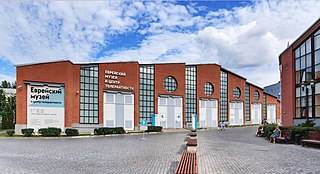
The history of the Jews in Russia and areas historically connected with it goes back at least 1,500 years. Jews in Russia have historically constituted a large religious and ethnic diaspora; the Russian Empire at one time hosted the largest population of Jews in the world. Within these territories, the primarily Ashkenazi Jewish communities of many different areas flourished and developed many of modern Judaism's most distinctive theological and cultural traditions, while also facing periods of antisemitic discriminatory policies and persecution, including violent pogroms.
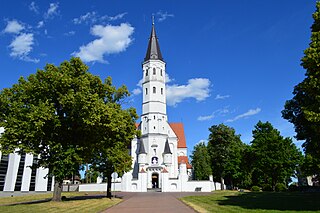
Šiauliai is a city in northern Lithuania, the country's fourth largest city and the sixth largest city in the Baltic States, with a population of 112 581 in 2024. From 1994 to 2010 it was the capital of Šiauliai County.
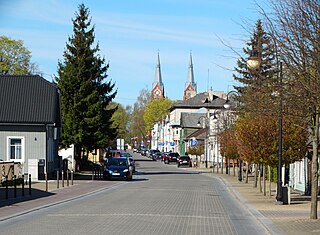
Jurbarkas is a city in Tauragė County, in Samogitia, Lithuania. Jurbarkas is located in the historic land of Karšuva. It is on the right-hand shore of the Nemunas at its confluence with the tributaries Mituva and Imsrė. The town became an important road junction after a bridge was built over the Nemunas in 1978.

Bila Tserkva is a city in central Ukraine. It is situated on the Ros River in the historical region of right-bank Ukraine. It is the largest city in Kyiv Oblast and serves as the administrative centre of Bila Tserkva Raion and Bila Tserkva urban hromada, and has a population of 207,273.
Great Synagogue or Grand Synagogue may refer to current or former synagogues in the following countries;
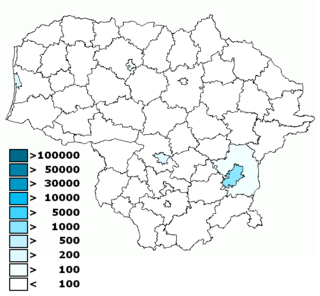
The history of the Jews in Lithuania spans the period from the 14th century to the present day. There is still a small community in the country, as well as an extensive Lithuanian Jewish diaspora in Israel, the United States, South Africa, and other countries.
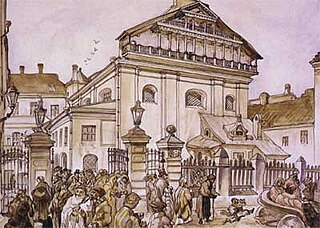
The Great Synagogue, officially, the Great City Synagogue in Vilna, also the Great Synagogue of Vilnius, is a former Orthodox Jewish congregation and synagogue, located atI-2 Jewish Street in the Old Town of Vilnius, in the Vilnius County of Lithuania.

The Great Choral Synagogue of Kyiv, also known as the Podil Synagogue or the Rozenberg Synagogue, is an Orthodox Jewish synagogue, located in the Podil, a historic neighborhood of Kyiv, Ukraine. Built in 1895, it is the oldest synagogue in Kyiv and is under the leadership of Rabbi Yaakov Bleich Chief Rabbi of Ukraine.

The Czernowitz Synagogue, also called The Temple of Czernowitz was a former Reform Jewish synagogue located in Chernivtsi, in the Chernivtsi Oblast of Ukraine. The synagogue was built in 1873 in what was then called Czernowitz, in the Austrian Hungary Empire. Closed in 1940, the building was repurposed and used as a movie theater since 1959.
Moisei Iakovlevich Beregovsky was a Soviet Jewish folklorist and ethnomusicologist from Ukraine, who published mainly in Russian and Yiddish. He has been called the "foremost ethnomusicologist of Eastern European Jewry". His research and life's work included the collection, transcription and analysis of the melodies, texts and culture of Yiddish folk song, wordless melodies (nigunim), East European Jewish instrumental music for both dancing and listening, Purim plays, and exploration of the relationship between East European Jewish and Ukrainian traditional music.
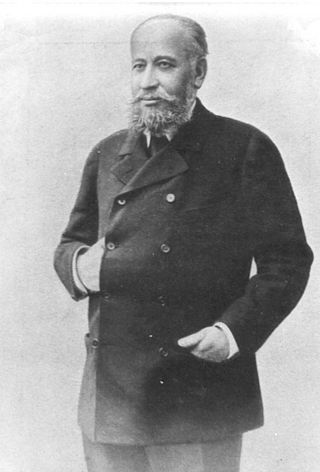
Lazar Izrayilevich Brodsky was a Russian businessman of Jewish origin, sugar magnate, philanthropist and patron.

The Choral Synagogue of Vilnius, officially, Taharat Ha-Kodesh Choral Synagogue in Vilnius, is an Orthodox Jewish congregation and synagogue, located at 39 Pylimo Street, in the Old Town of Vilnius, in the Vilnius County of Lithuania.
The history of the Jews in Kyiv stretches from the 10th century CE to the 21st century, and forms part of the history of the Jews in Ukraine.

The history of the Jews in Moscow goes back from the 17th century, the city of Moscow held 175,000 Jews from the Nazis although Moscow did not become an important Jewish center until the late 19th century when more Jews were legally allowed to settle. Prior to the 19th century, Jews had arrived in the city as prisoners of the Russo-Polish war or after 1790, as merchants allowed one month stays. In the late 1800s, the Jewish population boomed, and then dramatically dropped after the 1891 expulsion of Jews from the city. The population grew once again following World War I, and was a Jewish and Zionist cultural center until the end of the revolution, after which it became a Soviet Jewish center for a period of time. The Moscow Jewish community experienced a number of highs and lows under the Soviet Union as Jewish identity became increasingly taboo in the eyes of the government. After the collapse of the Soviet government and the mass migration of a huge portion of Russian Jews from the country, Moscow has still maintained a sizable Jewish population.
The history of the Jews in Saint Petersburg dates back to the 18th century and there is still a Jewish community in the city today. In the late 18th century, the annexation of eastern Poland meant millions more Jews were now subjects of the Russian Empire, many of whom flocked to the city. When Catherine the Great created the Pale of Settlement to attempt to contain the new Jewish population, Jewish settlement was largely restricted. Under Tsar Alexander II upper class Jews fitting certain criteria were allowed to live in the city, and many other Jews who did not fit these categories settled illegally. By the end of his reign in 1881, the Jewish population of the city was 17,253. Unlike other cities in the Russian Empire, Saint Petersburg never had a pogrom, likely due to the amount of police and army presence it had as the capital. The community continued to grow, despite expulsions and persecution, and flourished creatively until the Bolshevik Revolution. Under the Soviet Union, Jewish life was stifled and repressed, and a number of Saint Petersburg Jews took part in the refusenik movement and underground revival of Jewish nationalism. Today, after the collapse of the Soviet Union, the city remains home to a sizable Jewish community and many Jewish institutions. The Grand Choral Synagogue of Saint Petersburg is the third-largest synagogue in Europe.
Choral Synagogue may refer to:

This article presents the timeline of selected events concerning the history of the Jews in Lithuania and Belarus from the fourteenth century when the region was ruled by the Grand Duchy of Lithuania.
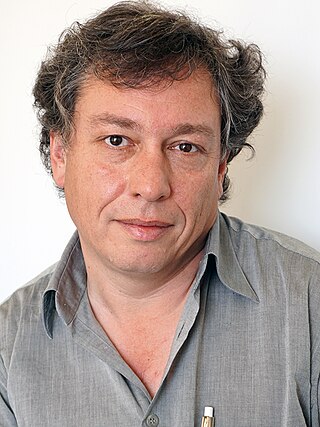
Vladimir Levin is an Israeli historian specializing in east European Jewish history. Since 2011, he has been a director of the Center for Jewish Art at the Hebrew University of Jerusalem.
References
- 1 2 Krinsky, Carol Herselle. "Synagogue Architecture". The YIVO Encyclopedia of Jews in Eastern Europe. YIVO Institute for Jewish Research. Retrieved 2014-10-06.
- 1 2 Meir, Natan M. (2010). Kyiv, Jewish Metropolis: A History, 1859-1914. Indiana University Press. p. 172. ISBN 9780253222077.
- ↑ Levin, Vladimir (2010). "A Historical Overview". Synagogues in Lithuania. A Catalogue. Vol. I. Vilnius Academy of Arts Press. p. 27. ISBN 978-9955-854-60-9.
- ↑ Vladimir Levin (2020). "Reform or Consensus? Choral Synagogues in the Russian Empire". Arts. 9: 1–49. doi: 10.3390/arts9020072 .